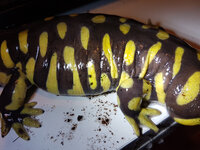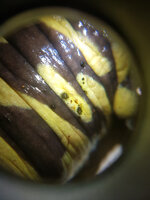scleroglossa
New member
Hi all; first-time poster, long-time reader.
I'll try to keep it brief.
I have a year-old, captive-bred Ambystoma tigrinum living in a 90-wide Exo Terra with 3-5 inches of coco fiber, who has started developing small (pinhead-sized) black spots on his skin. They're present throughout his patterning, and have a different texture to his skin. I'm assuming (for now) that this is the start of a fungal/bacterial infection.
This is almost certainly due to husbandry error on my part, and I'm unspeakably angry at myself. I'd provided him with a shallow plastic tray filled with (treated) water, changed daily, as a "wet" side, in addition to a heaped-up pile of coco fiber with cork hides etc on the "dry" side. I noticed he was spending a lot of time either in or buried directly underneath his water area, but dismissed it as "he's still digging like he should be". I piled more coco fiber on the "dry" side and stopped running the UVB light (Arcadia Shadedweller) as much during the day... yep, I realize now what a mistake that was as well. In the last few weeks I noticed that he was startling and bolting any time he was in the water area and something moved outside the vivarium, and remarked to my mum how unusual it was. Sometimes he would bolt as I was feeding him. I noticed the black spots late last night and made a note to check him today and remove his water dish. When I did, the spots were already noticeably bigger.
It'll be a vet visit as soon as I can feasibly book one (assuming this exotics vet has experience with amphibians). Until then, I'm reading the Caudata instructions on salt baths.
My question is this: what kind of setup do I need to provide him with during this time, to both halt the spread of the infection whilst also not stressing him or damaging his skin further? Do I go full "damp paper towels as substrate and plastic hides", do I give him a fresh layer of coco fiber and just change it throughout his treatment, etc. If I do have to go the "damp paper towels as substrate" route, will he be okay not being able to display his natural burrowing behavior? He's still very active, a good weight, and has a normal appetite, so I don't want to over-correct and put him in a situation that's more stressful for him. Do I continue to provide him with a (small, shallow) water dish to soak in during this period, or is that a bad idea no matter how many times it gets cleaned?
Basically, if anyone could walk me through what my short-term setup and routine for an A. tigrinum with suspected skin issues should be, I would be hugely grateful - as you can imagine, I'm trying to triple-check with more experienced keepers before I make any more husbandry decisions.......
I'll try to keep it brief.
I have a year-old, captive-bred Ambystoma tigrinum living in a 90-wide Exo Terra with 3-5 inches of coco fiber, who has started developing small (pinhead-sized) black spots on his skin. They're present throughout his patterning, and have a different texture to his skin. I'm assuming (for now) that this is the start of a fungal/bacterial infection.
This is almost certainly due to husbandry error on my part, and I'm unspeakably angry at myself. I'd provided him with a shallow plastic tray filled with (treated) water, changed daily, as a "wet" side, in addition to a heaped-up pile of coco fiber with cork hides etc on the "dry" side. I noticed he was spending a lot of time either in or buried directly underneath his water area, but dismissed it as "he's still digging like he should be". I piled more coco fiber on the "dry" side and stopped running the UVB light (Arcadia Shadedweller) as much during the day... yep, I realize now what a mistake that was as well. In the last few weeks I noticed that he was startling and bolting any time he was in the water area and something moved outside the vivarium, and remarked to my mum how unusual it was. Sometimes he would bolt as I was feeding him. I noticed the black spots late last night and made a note to check him today and remove his water dish. When I did, the spots were already noticeably bigger.
It'll be a vet visit as soon as I can feasibly book one (assuming this exotics vet has experience with amphibians). Until then, I'm reading the Caudata instructions on salt baths.
My question is this: what kind of setup do I need to provide him with during this time, to both halt the spread of the infection whilst also not stressing him or damaging his skin further? Do I go full "damp paper towels as substrate and plastic hides", do I give him a fresh layer of coco fiber and just change it throughout his treatment, etc. If I do have to go the "damp paper towels as substrate" route, will he be okay not being able to display his natural burrowing behavior? He's still very active, a good weight, and has a normal appetite, so I don't want to over-correct and put him in a situation that's more stressful for him. Do I continue to provide him with a (small, shallow) water dish to soak in during this period, or is that a bad idea no matter how many times it gets cleaned?
Basically, if anyone could walk me through what my short-term setup and routine for an A. tigrinum with suspected skin issues should be, I would be hugely grateful - as you can imagine, I'm trying to triple-check with more experienced keepers before I make any more husbandry decisions.......


